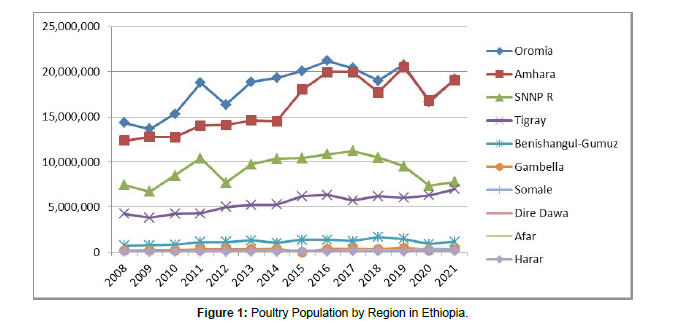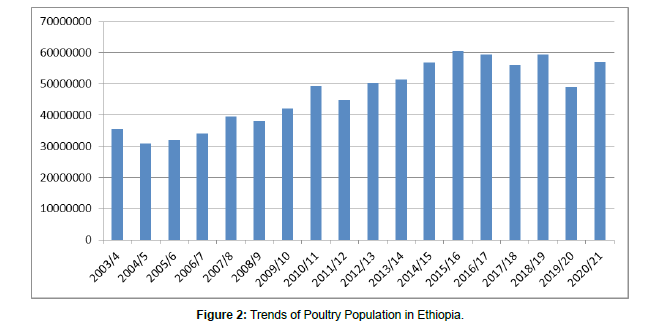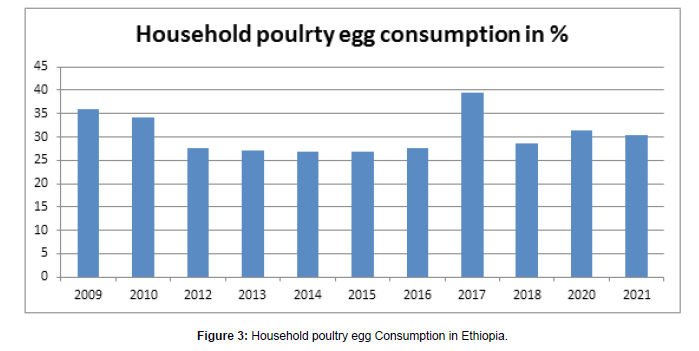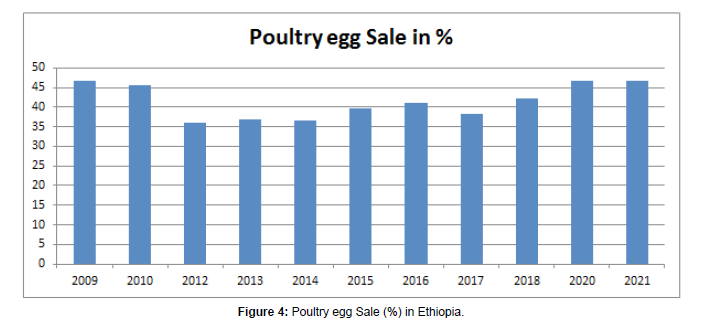Review on Poultry Production, Trends and Development Strategies in Ethiopia
Received: 03-Oct-2023 / Manuscript No. jflp-23-116743 / Editor assigned: 05-Oct-2023 / PreQC No. jflp-23-116743 / Reviewed: 19-Oct-2023 / QC No. jflp-23-116743 / Revised: 24-Oct-2023 / Manuscript No. jflp-23-116743 / Published Date: 31-Oct-2023 DOI: 10.4172/2332-2608.1000470
Abstract
Ethiopia has considerable livestock resource and poultry population is third ranked preceded by cattle and beehive. Besides their important and numbers, little is known about their production systems, population growth, egg utilization trends and development strategies in Ethiopia. The Ethiopian poultry population is almost entirely composed of indigenous chicken and recent estimates showed that poultry 81.7%, 10.9%, and 7.4% are indigenous, hybrids and exotic, respectively. The distribution of poultry population in Ethiopia is diverging from region to region. Oromia region has the largest number of poultry population followed by Amhara, South Nation and Nationality People of Ethiopia (SNNP). Poultry production system in Ethiopia is indigenous and an integral part of farming system. Based on the objective, breed, flock size, housing, feeding, health, biosecurity level and technology used, the poultry production system in Ethiopia can be classified into extensive or scavenging, semi-intensive, small-scale intensive and large scale commercial poultry production system. The extensive scavenging and small-extensive scavenging systems are the dominant forms of poultry production in Ethiopia. The poultry population growth over the year almost stagnant because of high poultry mortality due to lack of adaptation of introduced exotic poultry, diseases, predators prevalent in the scavenging production systems and limited expansion of commercial poultry production both in terms of number of operators and volume of operation. The poultry sector did not have a clear roadmap guiding its development until the recent production of the LMP. The future study should be attention on to expansion of large scale commercial poultry production system, constraints of poultry population growth, adaption of introduced exotic poultry breeds and the reason for eggs sale and household consumption fluctuated.
Keywords
Ethiopia; Poultry; Poultry population; Poultry production
Introduction
Ethiopia has large poultry population, estimated to be 41.35 million preceded by cattle, 66.26 and goats, 45.71 [1]. Poultry is one of the most important agricultural subsectors for rural communities in Ethiopia and poultry population is almost entirely composed of indigenous chicken and recent estimates showed that 78.04%, 117.58%, and 4.38% are indigenous, hybrids and exotic poultry, respectively [1]. Poultry production has an important economic, social and cultural benefit and plays a significant role in family nutrition in the developing countries. The proportional contribution of poultry to the total animal protein production of the world by the year 2020 is believed to increase to 40%, the major increase being in the developing world [2 ].
Poultry production system in Ethiopia is indigenous and an integral part of farming system; predominantly prevailing in the country and it is characterized by small flock, minimal input and unorganized marketing system [3]. The poultry production systems of Ethiopia are classified into extensive scavenging, semi-intensive, smallscale intensive and large-scale commercial poultry production system [4]. Within such systems, there are large variations among producers in terms of technology use, management level and scale of operation. Semi-intensive and large-scale intensive poultry producers are mainly located in and around cities and major towns such as Addis Ababa, Debre Zeit and Adama. Broiler production is concentrated in Adama, Modjo and Debre Zeit; pullet rearing is heavily concentrated in Debre Zeit; while egg production is mainly in Addis Ababa [4].
The total number of small-scale intensive poultry producers and their specific contribution to the national poultry production is not known. However, they provide the largest share of poultry eggs and meat to the growing urban population [5]. The extensive scavenging and small-extensive scavenging systems are the dominant forms of poultry production in Ethiopia [6]. The poultry population growth over the year almost stagnant because of high poultry mortality due to lack of adaptation of introduced exotic poultry, diseases, predators prevalent in the scavenging production systems and limited expansion of commercial poultry production both in terms of number of operators and volume of operation. Within this basic understanding the objective this review is:
• To review poultry production system in Ethiopia
• To review trends of poultry population and egg utilization in Ethiopia
• To review poultry production development strategies in Ethiopia
Literature Review
Overview on poultry production and distributions in Ethiopia
Poultry includes all domestic birds kept for the purpose of human food production (meat and eggs). In Ethiopia ostrich, ducks, guinea fowls, doves and pigeons are found in their natural habitat (wild) whereas, geese and turkey are exceptionally not common in the country. In Ethiopia, Poultry is primarily a backyard operation with a few low-productivity scavenging birds. The eggs and meat produced in this way are insufficient to supply the increased demand for eggs and poultry meat in metropolitan areas. The price of eggs and meat has been steadily rising, indicating rising local demand [7 ].
There is no recorded evidence indicating the exact time and locations of introduction of the first batch of exotic breeds of chickens into Ethiopia [8 ]. It is widely believed that the importation of the first batch of exotic poultry was probably done by missionaries. Four breeds of exotic chicken (Rhode Island Red, Australop, New Hampshire and White Leghorns) were imported to Jimma and Haramaya in 1953 and 1956, respectively under USAID project [9]. Poultry farming offers considerable economic, social, and cultural benefits in developing nations, and it plays an important part in family nutrition. The average number of birds kept by rural households is five or six. On top of these, the Ministry of Agriculture established several exotic chicken breeding and multiplication centers at different parts of the country to enhance the national poultry extension activities. Ethiopia has considerable livestock resource and Poultry population is third ranked preceded by cattle and Goats [10]. Oromia region has largest number of poultry population followed by Amhara, South Nation and Nationality People of Ethiopia (SNNP) and Tigray region. According to CSA [11] reported that Oromia, Amhara and South Nation and Nationality People of Ethiopia regions has about 33.62%, 33.44%, 16.91% and 12.28% of the total poultry population of the country, respectively.
Poultry production system in Ethiopia
Poultry can be reared in different management and production systems. Based on the objective, breed, flock size, housing, feeding, health, Biosecurity level and technology used, the poultry production systems of Ethiopia are classified into extensive scavenging, semiintensive, small-scale intensive and large-scale commercial poultry production system [12 -15 ].
Extensive or scavenging poultry production system
The production system in extensive or scavenging has kept few birds, specific poultry houses are rare, scavenging and occasional feeding with home grains and refuse, no regular health program with no biosecurity and no formal marketing channel. Birds kept in this system are usually native, dual-use breeds that are adapted to the scavenging production environment. From small to large scale, with the exception of extensive or scavenging, the production system has maintained hybrid and exotic breeds [4,12,13].
This poultry production system is practiced in most rural areas of the country and objectives of production are for household consumption and as source of additional income for the household. It covers 95-98% of the poultry production system of the country and it is not profitable since it is not market oriented. Birds have no or little supplementary feeds and no housing and Chicks are produced through natural incubation. This system is also characterized by high chicken mortality (often >70%) due to lack of proper health care and veterinary services ((FAO, 2019; Management Entity, 11). In this system, poultry keeping is mainly an activity undertaken by women often as a source of supplementary income. Poultry can contribute to as much as 20- 25% of the household income, much of which is controlled by women [14]. A study by [15] found that decisions on the income generated from scavenging poultry were made by women in 30% of the cases and by both women and men in about 54% of the cases. Poultry income is often used to cover school expenses, indicating that targeting rural women in family poultry development schemes does not only mean empowering women but also contributing to the education of their children (FAO, 2019; Management Entity, 2021).
Semi-intensive poultry production system
The semi-intensive poultry production system is characterized by flocks ranging from 50 to 200 birds, using commercial, crossbred, or indigenous breeds reared under scavenging management conditions with regular supplementation. Unlike in scavenging systems, birds are provided with housing and improved health care, resulting in low to medium mortality rates from 20 to >50% (Management Entity, 2021). The Ethiopian Livestock Master Plan (LMP) estimated that there were about 120000 households under the semi-intensive family poultry system in 2014 [5]. However, the CSA report shows that the number of poultry holders with flock sizes ranging from 10-49 is about 1,670,429, 100 to 199 is only about 2,359,and 50 to 99 is 9,700 (CSA, 11).
Small-scale intensive poultry production system
This system involves use of specialized, commercial day-old-chicks or pullets (200-1,000 broilers, 100-500 layers), commercial balanced rations, and good quality poultry houses. Producers in this system have full access to veterinary services and the mortality rates are low to medium (<20%). It is rapidly growing in the urban and peri-urban areas of the country and mostly run as family businesses and considered as important sources of income for many families. It currently plays a significant role in the employment of youth (FAO, 2019). Producers obtain day-old-chicks from the medium- and large-scale intensive poultry farms and hatcheries. They purchase compound feeds from large scale intensive farms and feed mills, such as Alema Koudijs Feeds, but their supply is inadequate and intermittent. Most of the feed used by these producers comes from smaller feed mills, which include those preparing small quantities of poultry feeds at the household level and smaller feed mills processing feeds for poultry, sheep, goats, and dairy cattle( FAO,2019, Management Entity, 2021).
Large scale commercial poultry production system
It is a highly intensive production system that involves, on average, greater or equal to 10,000 birds kept under indoor conditions with a medium to high bio‐security level. It is heavily depends on imported exotic breeds that require intensive inputs such as feed, housing, health, and modern management system and characterized by higher level of productivity where poultry production is entirely marketoriented to meet the large poultry demand in major cities [8 ]. The role of the commercial sector is increasing (16.52% meat production and 25% egg production) and overtaking the share of the extensive poultry production system in terms of production volume. The commercial poultry sector has about 71,000 broiler breeder stock, 87,300-layer breeder stock and 141,700 dual-purpose parent stock (ENTAG, 2020). All the large-scale and some of the medium scale poultry farms depend on their own parent stock to ensure sustainable production of dayold- chicks. Based on data collected by ENTAG (2020), annual egg production is estimated at 1.83 billion eggs or about 73,357 tons. The population of indigenous layers has declined in the past 10 years due to expansion of the commercial sector.
Trends of poultry population in Ethiopia
Ethiopia has about 60% of the total chicken population of East Africa, which includes local, exotic and hybrid chicken breeds. About 78.85% of the Ethiopian poultry population consists of indigenous chickens, while the remaining 21.14% consists of exotic and hybrid breeds of poultry. The total number of poultry at country level is estimated at around 57.01 million (CSA, 2021). The largest proportion of poultry consists of laying hens (34.26%), followed by chicks (32.86%). Pullets account for an estimated 11.36% of the country’s population. Cocks and cockerels are estimated about 11.2% and 5.74%, respectively. The rest is non-laying hens, which represent about 4.59% of the country’s total poultry population (CSA, 2021). The poultry population growth over the year almost stagnant because of high poultry mortality due to lack of adaptation of introduced exotic poultry, diseases, predators prevalent in the scavenging production systems and limited expansion of commercial poultry production both in terms of number of operators and volume of operation. The total poultry population of Ethiopia from 2003/4-2020/21 is presented in Figure 1.
Trends of poultry egg utilization in Ethiopia
Information on poultry egg house consumption and hen eggs sale is presented in Figure 2. The general trend is that eggs sale has increased from 2018 to 2021. The trends in eggs sale fluctuated until they showed sharp rises in 2018. Compared to 2012, the percentage of egg sale increased in 2016, while 2017 percentage of egg sale decreases. However, the general trends are that household egg consumption fluctuated from year to year (2009-2021). According to CSA (2021) egg is largely used for sale followed by used for household consumption (46.63, 30.36) percent of the total egg production. One fifth of the egg production in the country (that is about 22.75 percent) was used for other purposes and that could be for hatching. The reason for eggs sale and household consumption fluctuated is not clear (Figures 3-5).
Poultry production development strategies
So far, extension support for developing intensive poultry production systems (from large- to small-scale) has not been carried out in Ethiopia. With the exception of the very limited interventions initiated at the beginning of the GTP II period (2016) to support semi-intensive family poultry production systems, the extensive scavenging family poultry system has been the sole beneficiary of government extension services and technical support. In the past decades, considerable attempts were made to improve the productivity of extensive scavenging and small-extensive scavenging family poultry (FAO, 2019).
Nearly all of these attempts focused on improving the poor production performance of indigenous chickens through replacement with exotic breeds. The extension schemes largely constituted in the distribution of pullets at point of lay (usually from 5-10 per household). Other inputs and services such as feed, veterinary services and training on improved management practices were not part of the package. As a result, the birds did not survive the challenges of the scavenging environment. In the 1980s, the Minter of Agriculture initiated a cockerel distribution scheme. The cockerel distribution arrangement failed because farmers were unwilling to eliminate their indigenous cocks and the exotic cocks failed to adapt to the environments. During the late 1990s, the Ministry of Agriculture developed a new set of packages aiming to address the extensive and small-extensive scavenging, semi-intensive and small-scale intensive family poultry production systems (FAO, 2019).
Over the past couple of years, small and micro enterprises (SMEs) have become involved in day old chickens growing and other specialized activities related to poultry production. This has occurred as part of the country’s initiative to expand employment opportunities for youth and women around towns and cities. This scheme consists of a contractual arrangement with large private poultry companies that supply vaccinated day old chickens and feed to raise the chickens until 45 days of age with technical backstopping of the government extension services. The 45-day old chickens are eventually distributed chiefly to the scavenging family poultry producers through the extension system.
Although lack of adequate extension support and poor market linkages challenged the scheme it seems to hold a promising future (FAO, 2019).
The other notable strategy for developing the sector is probably the plan of the Ethiopian Agricultural Transformation Agency (ATA) initiated in the middle of the GTP II period (2016- 2020) which aims to transform the scavenging family poultry systems into semi-intensive family poultry production systems in selected poultry commercialization clusters located in the SNNPR, Oromia, Amhara and Tigray regions. The poultry sector did not have a clear roadmap guiding its development until the recent production of the LMP [5].
The poultry development road map was prepared in the context of the country’s growth and transformation plan (GTP II, 2016-2020) and its subsequent phases projected until 2030. The MoA is expected to release the final version of this document. The EIAR has also developed a comprehensive research strategy for the coming 15 years - 2016-2030 (EIAR, 2017). The other important recent initiative of the MoA relates to improving the existing poor veterinary services through privatizing the delivery of veterinary clinical services and upgrading the public veterinary services. To this end, the Ministry developed the veterinary rationalization road map which is expected to be implemented soon (FAO, 2019).
Conclusion
Ethiopia has considerable livestock resource and poultry population is third ranked preceded by cattle and beehive. Poultry is one of the most important agricultural subsectors for rural communities in Ethiopia and poultry population is almost entirely composed of indigenous chicken. Poultry production has an important economic, social and cultural benefit and plays a significant role in family nutrition in the developing countries. Poultry production system in Ethiopia is indigenous and an integral part of farming system and predominantly prevailing in the country and it is characterized by small flock, minimal input and unorganized marketing system. Based on the objective, breed, flock size, housing, feeding, health, Biosecurity level and technology used, the poultry production system in Ethiopia can be classified into extensive scavenging, semi-intensive, small-scale intensive and large-scale commercial poultry production system. The poultry population growth over the year almost stagnant because of high poultry mortality due to lack of adaptation of introduced exotic poultry, diseases, predators prevalent in the scavenging production systems and limited expansion of commercial poultry production both in terms of number of operators and volume of operation. But their distributions by the regions are varying. Oromia region has largest number of poultry population followed by Amhara, South Nation and Nationality People of Ethiopia (SNNP) and Tigray region. Egg utilization in Ethiopia is largely used for sale followed by used for household consumption percent of the total egg production. The extension support for developing intensive poultry production systems (from large- to small-scale) has not been carried out in Ethiopia. In the past decades, considerable attempts were made to improve the productivity of extensive scavenging and small-extensive scavenging family poultry.
From this review I recommend that:
• To increase adaption of introduced exotic poultry breeds in all regions at urban, per-urban and village production system for semiintensive, small-scale intensive poultry production system.
• To improve poultry production it is better to use large scale Commercial production system at urban area and village production system with better supplementations at rural area.
• Since poultry eggs are highly nutritious household consumption should be advanced rather than selling eggs.
• To increase poultry production and meat consumption domestication of other poultry species (turkeys, ducks, geese, ostriches,
guinea fowls, doves and pigeons) and solving of all the constraints is better.
• Government should be focused on improving the poor production performance of indigenous chickens aid by research.
• The poultry sector should have a clear roadmap guiding its development for production of the LMP.
References
- CSA (2022) Agricultural Sample Survey, Volume II report on livestock and livestock characteristics (private peasant holdings). Central Statistical Agency (CSA): Addis Ababa, Ethiopia.
- FAO (2010) Chicken genetic resources used in smallholder production systems and opportunities for their development. FAO Smallholder Poultry Production Paper NO. 5.
- Solomon D (2007) Suitability of hay box brooding technology to the rural household poultry production system. Inter J Res Sust Develop World Agri CIPAV, Cali, Colombia.
- Biazen A, Mengistu U, Negassi A, Getenet A, Solomon A, et al. (2019b) FAO Poultry Sector Ethiopia, Animal Production and Health Livestock Country Reviews. No. 11. Rome.
- Shapiro BI, Gebru G, Desta S, Negassa A, Nigussie K, et al. (2015) Ethiopia livestock master plan. ILRI Project Report. Inter Live Res Inst (ILRI).
- CSA (2020) Agricultural Sample Survey Volume II report on livestock and livestock characteristics (private peasant holdings). Central Statistical Agency (CSA): Addis Ababa, Ethiopia.
- Kumsa B, Beyecha K, Geloye M (2008) Ectoparasites of sheep in three agro-ecological zones in central Oromia, Ethiopia. Onderstepoort J Vet Res 79: 1-7.
- Fitsum M, Aliy M (2014) Poultry Production System and Role of Poultry Production in Tigray Region, Northern Ethiopia: A Review. J Biol Agri Healthc 4: 27.
- Solomon D (2007) Suitability of hay box brooding technology to the rural household poultry production system. Inter J Res Sust Develop World Agri CIPAV, Cali, Colombia.
- CSA (2022) Agricultural Sample Survey, Volume II report on livestock and livestock characteristics (private peasant holdings). Central Statistical Agency (CSA): Addis Ababa, Ethiopia.
- Mekuriaw Z, Harris-Coble L (2021) Ethiopia’s Livestock Systems: Overview and Areas of Inquiry. Gainesville, FL, USA: Feed the Future Innovation Lab for Livestock Systems.
- Emebet M, Mesekel KG (2016) Importance of Traditional, Small Scale and Commercial Poultry Production in Ethiopia: A Review. British J Poultry Sci 5: 01-08.
- Ayele, G. & Rich, K.M. 2010. Poultry value chains and HPAI in Ethiopia. HPAI pro-poor HPAI risk reduction. Africa/Indonesia Team Working Paper 25.
- Gebremedhin, B., Tesema, E., Tegegne, A., Hoekstra, D. & Nicola, S. 2016.Value chain opportunities for women and young people in livestock production in Ethiopia: Lessons learned. Lives Working Paper No 24.
- Tona MG (2018) Poultry Production, Consumption, Marketing and Associated Challenges in Ethiopia. Bri J Poultry Sci 7: 16-28.
Indexed at, Google Scholar, Crossref
Citation: Urgesa L (2023) Review on Poultry Production, Trends and DevelopmentStrategies in Ethiopia. J Fisheries Livest Prod 11: 470. DOI: 10.4172/2332-2608.1000470
Copyright: © 2023 Urgesa L. This is an open-access article distributed under theterms of the Creative Commons Attribution License, which permits unrestricteduse, distribution, and reproduction in any medium, provided the original author andsource are credited.
Select your language of interest to view the total content in your interested language
Share This Article
Recommended Journals
Open Access Journals
Article Tools
Article Usage
- Total views: 2329
- [From(publication date): 0-2023 - Nov 22, 2025]
- Breakdown by view type
- HTML page views: 1950
- PDF downloads: 379





